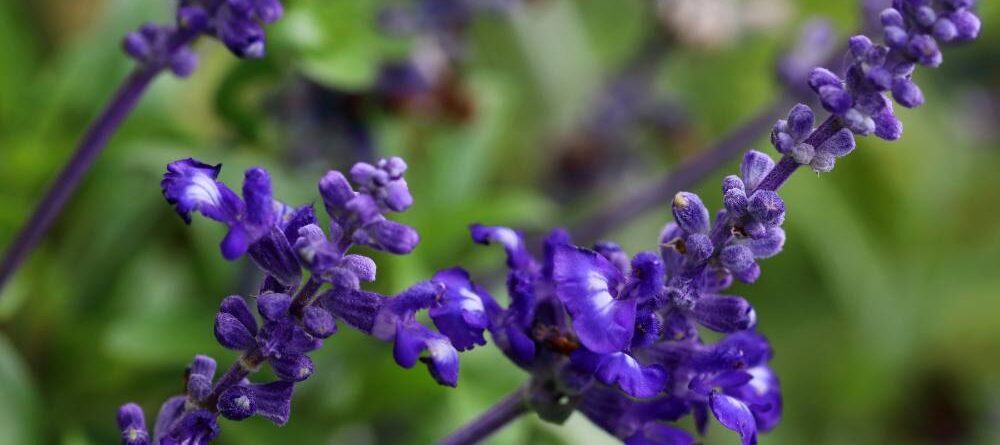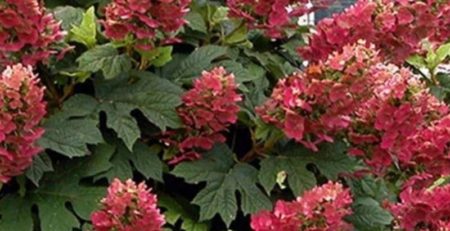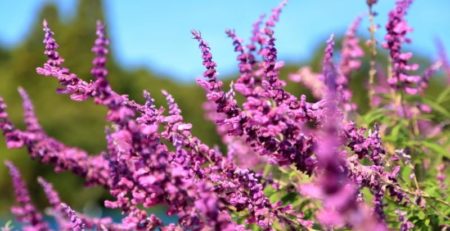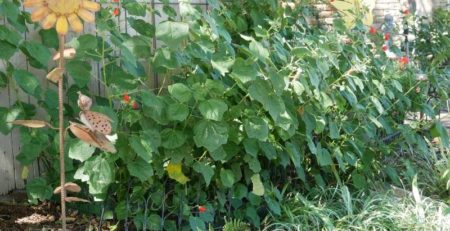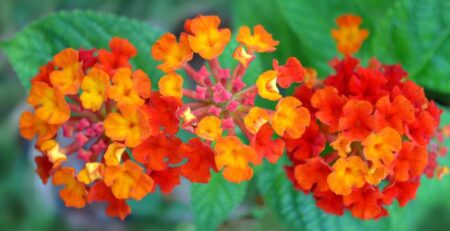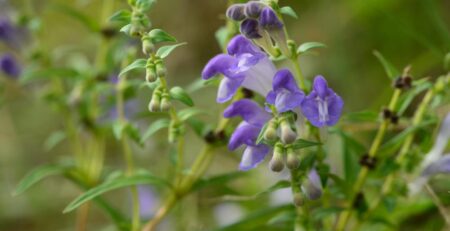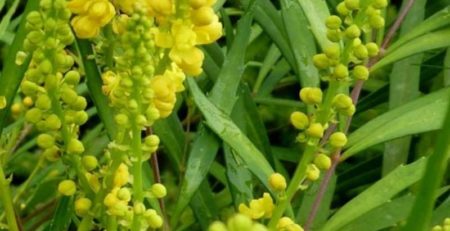Mystic Spires
Description: A standout addition to any garden, Mystic Spires Blue Salvia is a result of the cross between Salvia longispicata and Salvia farinacea, renowned for its long-lasting blooms and striking blue hue. Especially well-suited for use in borders and mass plantings, it adds an interesting texture and a pop of color to any landscape, while its moderate growth rate and rounded form make it an easy addition to container gardens. Its flower spikes are covered with small, tubular, indigo-blue blooms from early summer until frost, ensuring a showy display throughout the season. Plant maintenance demands only modest effort with deadheading spent blooms being the primary task, although this is not essential as the plant tends to clean itself. Attracting hummingbirds and butterflies with its vibrant colors and sweet nectar, the Mystic Spires Blue Salvia offers an added benefit of being a source of food for those valuable pollinators. It is highly resistant to diseases and pests, showing ample resilience that makes it a preferred plant by many gardeners. It is also heat-tolerant, capable of thriving even in the warmest of summers without wilting. Despite its many attractive qualities, potential drawbacks do exist for Mystic Spires Blue Salvia. It does not perform well in overly wet conditions, so proper drainage is essential to prevent root rot or fungal diseases. Additionally, while it’s not typically considered invasive, it can be prolific under favorable conditions, potentially crowding out more delicate species. The plant is also not suitable as a houseplant due to its size and need for full sun. Despite these considerations, with its rich color, easy maintenance, and resilient nature, Mystic Spires Blue Salvia remains an appealing choice for home gardens.

Botanical Name: Salvia longispicata x farinacea
Common Name: Mystic Spires Blue Salvia, Salvia Indigo Spires, Mystic Spires Salvia, Blue Spires Salvia, Long Spiked Sage, Bicolor Sage, Farinaceous Sage
Synonyms: Salvia x pratensis
Category: Perennial
Family: Lamiaceae
Lifecycle: Perennial
Alt. Lifecycle: Annual
USDA Symbol: SAFA2
Hardiness Zone North: 7A
Hardiness Zone South: 10B
Sun Requirement: Full Sun (6+ hours of sun per day)
Sun Requirement (Alt): High Sun (4-6 hours of sun per day)
Water Requirement: Medium
Growth Rate: Moderate
Maintenance: Low
Plant Adult Height: 2-4 ft
Plant Adult Spread: 2-3 ft
Plant Spacing: 2-3 ft
Soil Preference: Sandy Loam
Soil pH Preference: Adaptable
Propagation: Seed, Stem Cutting
Propagation & Planting: To propagate the Mystic Spires Blue Salvia, you’ll begin by taking stem cuttings of healthy parent plants in early to mid-summer. Choose stems with new growth, remove approximately a 4- to 6-inch segment, making your cut just below a leaf node. Strip off the leaves on the lower half of your cutting. Dip the cut end in a good-quality rooting hormone to enhance root establishment. Plant the cutting into a well-draining potting mix, burying the lower half of the stem. Ensure the mix is moist, not waterlogged. Enclose the pot in a clear plastic bag to preserve soil moisture and maintain humidity levels. Place the potted cutting in a shady spot, avoiding direct sunlight, until roots are established. This rooting process usually takes 3-4 weeks. Once roots are developed, move the cutting to a brighter location with indirect sunlight to encourage growth. When preparing to plant your developed Mystic Spires Blue Salvia, choose a sunny location with well-draining soil. Dig a hole that’s twice the diameter of the root ball. Place the plant in the hole, ensuring the top of the root ball is level with the soil surface, and then backfill with soil and water thoroughly.
Plant Care: Mystic Spires Blue Salvia is a perennial plant that enjoys full sun and handles heat well. In the spring, start by pruning it back to half its height and put down a slow-release, balanced fertilizer to encourage vigorous growth. Throughout the summer, pay attention to watering. While this salvia is drought-tolerant, it prefers even, consistent moisture; overly soggy soil can lead to root rot. Mulch to conserve moisture and suppress weeds. Check regularly for pests or disease and treat them promptly to prevent spreading. To promote continuous flowering, remove faded blooms during summer; trimming leggy stems will encourage fuller growth. In early fall, trim the plant back slightly to tidy it up and help it transition into cooler weather. If desired, apply another round of fertilizer in late fall to nourish it through the winter months. Take steps to protect the plant from frost by covering it on particularly cold nights. In winter, limit watering to prevent root rot but don’t let it completely dry out. Prune it in late winter or early spring before new growth appears to maintain its size and shape. This salvia should be divided every 3-4 years in the early spring for best health and vitality.
Fertilize: To ensure the optimal growth and flowering of your Mystic Spires Blue Salvia, it is necessary to apply a balanced, slow-release fertilizer with the nutrient ratio of 14-14-14 (N-P-K) at planting time, as this variety thrives on a fair distribution of Nitrogen (N), Phosphorus (P) and Potassium (K). Follow product-specific instructions, but generally 1 to 2 tablespoons per plant is appropriate, mixed well into the soil around the plant’s roots. Additionally, you can top-dress the soil with a light layer of compost, which will gradually feed the plant as it breaks down. Throughout the growing season, switch to a high-phosphorus fertilizer to encourage blossom production. In this case, a blooming fertilizer with an NPK ratio of 15-30-15 would be recommended. Always remember, the key is to avoid over-fertilizing, which can cause salt buildup in the soil and damage to your salvia.
Prune: Pruning your Mystic Spires Blue Salvia should ideally be done in both the early spring, following the last frost, and mid-summer to promote bushier growth and encourage profuse blooming. For the early spring pruning, focus on removing old, dead growth from the previous season, and neaten up the overall shape of the plant. In mid-summer, trim back about one-third of the plant’s height to stimulate renewed vigor and enhance flowering into the fall. Make sure to prune spent flower spikes throughout the growing season to encourage new blooms. However, try to avoid pruning your Mystic Spires Blue Salvia in the fall as this can lead to an unhealthy plant through the cold winter months. Always use clean, sharp pruning tools to ensure clean cuts and prevent the spread of disease.
Pest & Disease: Identifying pests and diseases affecting Mystic Spires Blue Salvia requires a keen eye and timely treatment. For pests, look out for aphids – small, soft-bodied insects that suck the nutrient-rich liquids out of plants, leaving a sticky residue called honeydew, which can encourage mold growth. To treat aphids, you can use insecticidal soaps or a strong water spray to remove them from your plants. Spider mites can also infest these plants; they’re minute pests that cause yellowing or bronzing of the leaves. Use a miticide expressly made to control these pests. Among diseases, watch out for powdery mildew that manifests as a white powdery deposit over the plant’s surface. Treat this with a proper fungicide for prevention and control. Root rot may also occur if the salvia is overly watered or in poorly draining soil; symptoms include wilting and browning leaves, and rotting roots. Amend the soil with organic matter to increase drainage or utilize a fungicide formulated for root rot. Remember to always follow label directions when using treatments, to protect the plant and surrounding environment. Regular monitoring and early intervention will safeguard your Mystic Spires Blue Salvia against most common pests and diseases.
Attracts: Bees, Butterflies, Hummingbirds, Moths
Resists: Deer, Disease
Tolerates: Drought, Dry Soil, Heat
PlantTAGG® is the most technically advanced mobile solution for helping gardeners learn about and care for their plants. PlantTAGG’s goal to educate gardeners blends seamlessly with the mission of the Master Gardener program to provide research-based horticultural information to the residents of Dallas County and beyond. To set up your own yard, download the PlantTAGG app.

